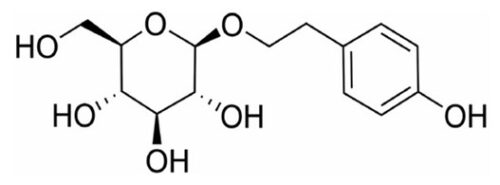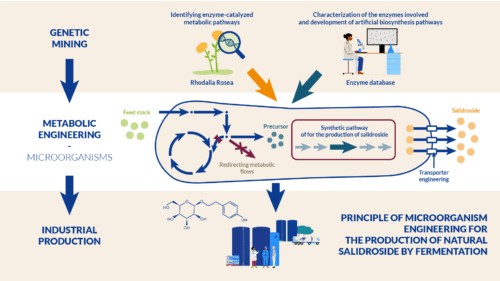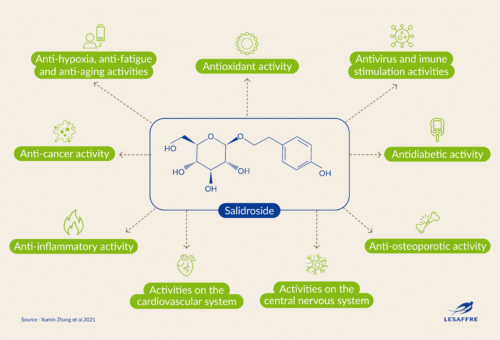What is salidroside? Understanding its origine in Rhodiola Rosea
Salidroside is the most studied bioactive component of Rhodiola rosea. Chemically known as 2-(4-hydroxyphenyl) ethyl-β-d-glucopyranoside, salidroside is a tyrosol glucoside. It is present in the roots of Rhodiola species, which owe their essential medicinal properties to it. The most commonly used species in dietary supplements are Rhodiola Rosea and Rhodiola Crenulata.

Rhodiola, also known as golden root, is an herbaceous perennial in the Crassulaceae family. Extremely hardy and cold-tolerant, it thrives in extreme climates, at high altitudes, on rocky slopes, cliffs and high mountain screes.
The underground part of Rhodiola is used in phytotherapy and nutraceuticals for its properties and health benefits. Like ginseng and Eleutherococcus, Rhodiola is an adaptogenic plant, meaning it helps support the body by increasing its resistance to various physical, chemical and biological stress factors.
Pure salidroside from fermentation: a sustainable and ethical source
Unfortunately, Rhodiola was recently added to the CITES (Convention on International Trade in Endangered Species of Wild Fauna and Flora) endangered species list. Against this backdrop, biosynthesis by microbial fermentation (yeast or bacteria) has emerged as a sustainable, environmentally-friendly alternative. Drawing on the bio-engineering platform of the Lesaffre Institute of Science & Technology (LIST), Gnosis by Lesaffre has developed LANDKIND® Pure Salidroside, a convenient replacement for Rhodiola extracts with its most potent active ingredient.
Philip G. Kasprzyk et al (2022) presented comprehensive trial results supporting the safety of salidroside manufactured using a patented sustainable bioengineering process. Their study confirms that salidroside produced using bacteria is a viable and safe alternative to salidroside derived from the harvesting of Rhodiola plants, and can be used as a dietary supplement, food ingredient or possibly as a pharmaceutical product.

Health benefits of salidroside
In China, where Rhodiola is recognized by traditional medicine, 8 Rhodiola-based medicines and 12 dietary supplements are marketed. In the United States, the only salidroside produced by fermentation (LANDKIND®) has received GRAS approval and is distributed by Gencor.
Salidroside is a highly researched bioactive compound with promising potential in numerous applications. More than 720 scientific articles, including 22 literature reviews, support its use as a stand-alone ingredient.
Studies have examined how Rhodiola rosea can help our bodies manage stress and fight fatigue. In 2022, E. Stojcheva and J.C. Quintela, for example, showed that Rhodiola rosea-based formulations can increase resistance to physical and mental stress. Its long-standing use as a medicinal plant and extensive clinical research into its energizing and anti-stress properties attest to its effectiveness in this respect. A study by V. Darbinyan et al (2007) demonstrated the plant’s effectiveness against fatigue, including mental exhaustion, which can have an impact on cognitive function.
Numerous recent studies, including those by Zhang et al (2021), Panossian & al. (2014) et al, Mangani et al (2020), highlight the particular interest of salidroside due to its unique biological properties: anti-fatigue, antioxidant, immunomodulatory, anti-diabetic, neuroprotective, anti-inflammatory, anti-cancer, cardiovascular and anti-osteoporotic effects.

Liang et al (2024) detail the numerous pharmacological effects of salidroside and suggest that its various properties could have promising applications in the treatment of certain diseases, notably neurodegenerative (Alzheimer’s disease, Parkinson’s disease, Huntington’s disease) and depression.
In addition, numerous recent studies highlight its anti-aging potential, suggesting that salidroside could slow down the aging process, notably by increasing the activities of endogenous antioxidant enzymes(7). Similarly, Mei & al (2023) point out that salidroside could serve as a candidate molecule for preventing UVB-induced photochemical damage to the skin.
How Salidroside Works: The Mechanisms Behind Its Benefits
Tests on in vitro cell models and in vivo animal models have highlighted the various mechanisms underlying salidroside’s potential protective effects, such as regulation of the oxidative stress response, inflammation, apoptosis, the hypothalamic-pituitary-adrenal axis, neurotransmission, neuronal regeneration and the cholinergic system.
Anti-inflammatory and antioxidant mechanisms with multi-target and multi-pathway activities are the most commonly put forward to explain salidroside’s protective effects.
Salidroside has a beneficial effect on stress by acting on the hypothalamic-pituitary-adrenal (HPA) axis, which links the brain and adrenal glands, and regulates the secretion of cortisol, the stress hormone.
Salidroside also exhibits protective effects on endothelial function by inhibiting cell apoptosis (cell death), oxidative stress and inflammation, and regulating metabolism (Leung et al., 2013). It could thus play a protective role in cardiovascular disease (atherosclerosis, myocardial lesions…) by protecting vascular endothelial cells and myocardial cells.
However, the exact mechanisms are not fully elucidated, but the available evidence suggests an important role in supporting human health and well-being in general, and stress management, cognitive function and cardiovascular health in particular.
The science behind salidroside: Clinical trials and research
Clinical trials have confirmed the value of salidroside administered via standardized extracts of Rhodiola, either in a version over 98% pure (Landkind®).
The role of Rhodiola rosea in stress-related fatigue
In 2000, V. Darbinyan et al. conducted a double-blind crossover study to investigate the effects of a standardized extract of R. rosea (SHR-5) administered as a repeated low-dose treatment on the mental performance of healthy doctors during night shifts. The experiment lasted two weeks. The results showed that fatigue scores were reduced and cognitive ability and overall mental performance were enhanced compared to placebo.
Similarly, in 2009, E. Olsson et al. reported that Rhodiola rosea SHR-5 extract triggers an anti-fatigue effect that improves mental performance, in particular the ability to concentrate, and reduces the cortisol response to wakefulness stress in patients suffering from exhaustion with fatigue syndrome.
The role of Rhodiola rosea and pure salidroside on sports performance
In 2010, A. Parisi et al. established that chronic supplementation with Rhodiola rosea can reduce both lactate levels and skeletal muscle damage parameters after exhaustive physical training sessions. Their observations confirm that Rhodiola rosea can increase adaptability to physical exercise.
Later, in 2013, E. Noreen et al. conducted a double-blind study on the effects of an acute oral dose of 3 mg/kg Rhodiola rosea on workout endurance performance, perceived exertion, mood and cognitive function in cyclists. They found that, compared with a placebo group, cyclists taking Rhodiola root had a lower heart rate during the warm-up to a training session and completed the timed event more quickly.
But what about the effects of pure salidroside supplementation produced by fermentation? In 2024, Schwarz & al. showed in an exploratory, double-blind, randomized, placebo-controlled study that 60 mg/day of pure salidroside (LandKind® Pure Salidroside) for around 2 weeks after aerobic exercise tests could improve oxygen utilization and attenuate exercise-induced muscle damage and fatigue.
Who is salidroside intended for?
Salidoside’s adaptogenic properties are of interest to top-level athletes as well as to people seeking to improve their well-being and cope with stress, whether physical or psychological. Salidroside may also be of interest to anyone wishing to improve cognitive performance under pressure.
Salidroside is intended for use as a dietary supplement with indications for use comparable to those of salidroside derived from Rhodiola extract.
Dosage and how to use salidroside safely
When taking Rhodiola rosea extracts, it is essential to follow recommended dosages and administration guidelines to maximize the benefits of salidroside. Research has shown that taking Rhodiola rosea WS®1375 200 mg twice a day for 4 weeks was safe and effective in improving stress-related symptoms(3).
In its pure form, 20 mg of Landkind® is equivalent to 2000 mg of Rhodiola Rosea (containing 1% naturally-occurring salidroside). In the Landkind® clinical study, participants received 60 mg salidroside daily for 16 days(16).
Note: People who are pregnant, breastfeeding or taking medication should consult their doctor before taking dietary supplements containing Rhodiola rosea or pure salidroside.
Rhodiola-based dietary supplements are best taken on an empty stomach or before breakfast (source Vidal).
Safety and side effects of salidroside
Available data on the safety of salidroside are limited. Consequently, current guidelines apply mainly to Rhodiola rosea-based dietary supplements. These products are generally considered safe when taken at recommended doses. However, as with any product containing active ingredients, there may be side effects, medical contraindications and some precautions to take when using Rhodiola rosea. Side effects may include gastrointestinal disturbances such as stomach upset, flatulence or digestive discomfort – particularly in sensitive individuals or if the recommended dose is exceeded. In addition, Rhodiola rosea may interact with various prescription drugs, including diabetes and blood pressure medications and antidepressants. It is not suitable for pregnant or breast-feeding women, children or people suffering from liver disease.
You should always consult your doctor before taking Rhodiola rosea and take care not to exceed the recommended daily dose.
Where can I buy high-quality salidroside supplements?
Consumers need to be vigilant when buying dietary supplements containing salidroside, as quality can vary depending on the brand or manufacturing method. Always check that the words “standardized extract” appear on the packaging, as this guarantees consistent levels of active compounds in each dose. The label should also include clear information on the content of salidroside and rosavins, another bioactive compound in Rhodalia, as well as the recommended daily dose, to ensure safe and effective dosing.
Other selection criteria can also be taken into account, such as the origin of the ingredients, whether they are organically grown or have been certified to meet purity and quality standards. To avoid products of dubious quality, it is advisable to look for dietary supplements from reputable brands that can be purchased from reliable retailers, whether in specialist stores or on trusted websites(4).
The future of salidroside research and its potential in modern medicine
The therapeutic potential of salidroside, a molecule of major interest to scientists researching adaptogens, is receiving increasing attention. Salidroside may also alleviate cognitive impairment associated with Alzheimer’s disease by inhibiting ferroptosis, a form of cell death. It has also been shown to have antidepressant-like effects.
Given salidroside’s known properties, this compound could be used in new therapeutic approaches aimed at treating chronic stress, fatigue and cognitive disorders.
Ongoing and future studies will help to better define its clinical efficacy and explore its potential in new therapeutic protocols(15) (17).
The challenges of growing interest in salidroside
Growing interest in salidroside has led to increased demand in the cognitive and sports nutrition market. A report published by Future Market Insights indicates that the size of the global sports nutrition market reached $22.5 billion in 2022 and is expected to reach $52.11 billion by 2032. The IMF estimates that market revenues will exceed $61.6 billion by 2033, implying a compound annual growth rate (CAGR) of 11.5% for the global sports nutrition market.
However, the growing interest in salidroside comes up against several difficulties:
- Rhodiola rosea‘s salidroside content is low, around 0.8% to 1%.
- Overexploitation of natural resources is a threat to wild Rhodiola populations.
- Cultivation is possible but difficult, as the plant has a very long maturation period between planting and harvesting (around 5 years),
- Chemical extraction and synthesis are inefficient.
Consequently, as noted by scientists such as Michael P. Torrens-Spence et al. (2018) and Philip G. Kasprzyk et al. (2022), obtaining salidroside from Rhodiola rosea roots is time-consuming and costly, and cannot be used on a large scale. It is therefore necessary to find safe and sustainable alternative sources to promote the clinical development of salidroside and meet the strong demand from the global market.
The 4 main benefits of salidroside-based dietary supplements in the United States:
- can improve mental clarity, concentration and overall cognitive performance
- can support the body’s natural ability to adapt to stress, both physical and mental
- can improve oxygen utilization during exercise
- can alleviate muscle damage and fatigue induced by physical exercise
Frequently asked questions (FAQ)
Where does salidroside come from?
Salidroside is found in Rhodiola roots. Today, precision fermentation enables the long-term production of high-purity salidroside.
What are the main benefits of salidroside?
Salidroside acts as an adaptogen, helping the body to cope better with stress. It also reduces fatigue and increases stamina and energy levels.
What is the recommended dosage for salidroside?
The salidroside content may vary according to the type of Rhodiola-based supplement (between 0.5 and 3%). Please refer to the information on the packaging. The recommended dose of pure salidroside is 60 mg/day.
Do not exceed the maximum recommended dose indicated on the product packaging.
Information sources
- Darbinyan V, Aslanyan G, Amroyan E, Gabrielyan E, Malmström C, Panossian A. Clinical trial of Rhodiola rosea L. extract SHR-5 in the treatment of mild to moderate depression. Nord J Psychiatry. 2007;61(5):343-8. PubMed
- Darbinyan V, Kteyan A, Panossian A, Gabielian E, Wikman G, Wagner H. Rhodiola rosea in stress induced fatigue – a double-blind cross-over study… 2000;7:365-71.
- Edwards D, Heufelder A, Zimmermann A. Therapeutic effects and safety of Rhodiola rosea extract WS® 1375… Phytother Res. 2012 Aug;26(8):1220-5. doi: 10.1002/ptr.3712.
- FDA – Dietary Supplements. https://www.fda.gov/consumers/consumer-updates/fda-101-dietary-supplements
- Kasprzyk PG, Vickery C, Ye M, Sewastianik M, Gong W, Ding S, Dziwenka M, Mozingo A, Valm K, Schachner H, Weng JK. Safety of a Sustainably Produced, Bioengineered… 2022 Jun 1;14(11):2330. doi: 10.3390/nu14112330.
- Leung SB, Zhang H, Lau CW, Huang Y, Lin Z. Salidroside improves homocysteine-induced endothelial dysfunction… Evid Based Complement Alternat Med. 2013;2013:679635. doi: 10.1155/2013/679635.
- Liang K, Ma S, Luo K, Wang R, Xiao C, Zhang X, Gao Y, Li M. Salidroside: An Overview of Its Promising Potential… 2024;17:1703. doi: 10.3390/ph17121703
- Magani SKJ, Mupparthi SD, Gollapalli BP, Shukla D, Tiwari AK, Gorantala J, Yarla NS, Tantravahi S. Salidroside – Can it be a Multifunctional Drug? Curr Drug Metab. 2020;21(7):512-524. doi: 10.2174/1389200221666200610172105.
- Manxue Mei, Ruhang Cai, Qihua Yu, Renkui Tian, Wei Zhu, Jianping Song, Dinghong Wu. Salidroside alleviates UVB-induced skin damage… J Funct Foods. 2023;107:105647. doi: 10.1016/j.jff.2023.105647
- Noreen Eric E, James G Buckley, Stephanie L Lewis, Josef Brandauer, Kristin J Stuempfle. The effects of an acute dose of rhodiola rosea on endurance exercise performance. J Strength Cond Res. 2013 Mar;27(3):839-47.
- Olsson EM, von Schéele B, Panossian AG. A randomised, double-blind, placebo-controlled study… Planta Med. 2009 Feb;75(2):105-12. doi: 10.1055/s-0028-1088346.
- Panossian A, Hamm R, Wikman G, Efferth T. Mechanism of action of Rhodiola, salidroside, tyrosol and triandrin… 2014 Sep 25;21(11):1325-48. doi: 10.1016/j.phymed.2014.07.008.
- Parisi A, Tranchita E, Duranti G, Ciminelli E, Quaranta F, Ceci R, Cerulli C, Borrione P, Sabatini S. Effects of chronic Rhodiola Rosea supplementation… J Sports Med Phys Fitness. 2010 Mar;50(1):57-63.
- Sports nutrition market outlook (2023-2033). https://www.futuremarketinsights.com/reports/sports-nutrition-market/
- Sanz-Barrio PM, Noreen EE, Gilsanz-Estebaranz L, Lorenzo-Calvo J, Martínez-Ferrán M, Pareja-Galeano H. Rhodiola rosea supplementation on sports performance… Phytother Res. 2023 Oct;37(10):4414-4428. doi: 10.1002/ptr.7950.
- Schwarz NA, Stratton MT, Colquhoun RJ, Manganti AM, Sherbourne M, Mourey F, … Weng JK. Salidroside and exercise performance in healthy adults… J Int Soc Sports Nutr. 2024;21(1). doi: 10.1080/15502783.2024.2433744
- Sixia Yang, Linshuang Wang, Yi Zeng, Yong Wang, Tingting Pei, Zeping Xie, Qiaowu Xiong, Hui Wei, Wenxu Li, Jiaqi Li, Qian Su, Dongfeng Wei, Weidong Cheng. Salidroside alleviates cognitive impairment… 2023;114:154762. doi: 10.1016/j.phymed.2023.154762
- Stojcheva Ivanova E, Quintela JC. The Effectiveness of Rhodiola rosea L. Preparations in Alleviating… 2022 Jun 17;27(12):3902. doi: 10.3390/molecules27123902.
- Torrens-Spence Michael P. Toma Pluskal, Fu-Shuang Li, Valentina Carballo, Jing-Ke Weng. Complete elucidation of the pathway… Molecular Plant. 2018 Jan 8;11(1):205-217.
- Xing S, Xu S, Wang L, et al. Salidroside exerts antidepressant… Acta Neuropsychiatrica. 2024;36(6):446-456. doi: 10.1017/neu.2024.28
- Zhang X, Xie L, Long J, Xie Q, Zheng Y, Liu K, Li X. Salidroside: A review of its recent advances… Chem Biol Interact. 2021 Apr 25;339:109268. doi: 10.1016/j.cbi.2020.109268.


